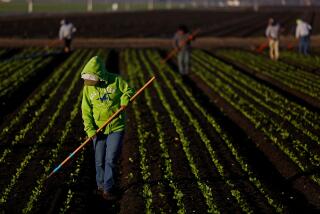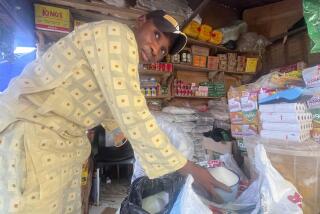Global Surplus Adds Pressure on U.S. Farmers
CHICAGO — World farm productivity is soaring, agricultural goods are piling up around the globe and international markets are stagnating--all indications that financially distressed American farmers face a prolonged period of hard times.
There are huge surpluses of almost every major agricultural commodity from grains and beef to butter and beans. Their accumulation means that American farmers can expect little relief by increasing their exports, the lift they--and the Reagan Administration--had hoped would pull them out of their economic quagmire.
Instead, worldwide agricultural conditions may help to accelerate the demise of mid-sized commercial family farms in the U.S.
Hardship Expected to Spread
And mounting supplies of food in the world suggest that family farmers in other developed, agriculturally productive countries will soon experience the economic hardship now so familiar to their American counterparts.
“There is not room in the world for all of the farm products which are currently being produced,” said Dennis T. Avery, a senior analyst in the U.S. State Department’s Bureau of Intelligence and Research. “The world is awash in farm surpluses.”
That is a cruel irony in the wake of famine and starvation in parts of Africa. But the problems there, which began with a severe drought, persist because of political problems and a variety of distribution and transportation difficulties.
“We face the inevitable--if we don’t take avoiding action--of a world market where prices in the medium term can only go down,” said Alan Wilkinson, an economist at the Brussels headquarters of the European Common Market.
“The prospects are gloomy for a quick solution to the world grain glut,” Jean-Pierre Andrault, chief economist for the French Wheat Producers Assn., said in a Paris interview. “Some experts think that by the year 1990 or 2000 there will be an increase in world trade,” he added. “But it will not be greater than the increase in yields or productivity.”
The growth in productivity can be seen in this year’s American corn crop. It is expected to be the biggest ever, even though two-thirds of the country’s farmers planted 10% fewer acres of corn.
Since 1949, the number of acres needed for all of America’s domestic food requirements has dropped from 315 million to 228 million acres. John E. Lee Jr., administrator of the Department of Agriculture’s Economic Research Service, estimates that the United States will need less than half of its present cropland to supply the country by the year 2000.
And the boom in productivity is not limited to the United States.
“The rest of the world is now undergoing the same sort of technological revolution that transformed American agriculture in the 1950s and 1960s,” the State Department’s Avery told the Illinois Bankers Assn. last month.
In just 25 years, high technology has spread from countries with about 50% of the world’s arable land to those that now have 90% of such land, an expansion that has contributed to global surpluses.
There have now been five consecutive years of worldwide record rice crops. In that same period world wheat production increased 14%. Surplus supplies of sugar are sufficient to meet 40% of the world’s annual needs. The surplus of cotton is a record. The European Common Market has 800,000 metric tons of meat in storage.
U.S. Prices Undercut
American farmers have more competitors than ever on world markets. Most are able to undercut U.S. commodity prices kept high by government price supports and out of reach of some buyers by the strong dollar. Some economists see a trend that may make the United States, once a primary supplier, a residual supplier of commodities in the future.
There are already signs that this is happening. In the last 10 years, American cotton exports have dropped 40%, and since 1980, cereal grain exports have declined almost 12%.
But even agriculturally developed competitors, like those in the European Common Market, are begining to feel the pinch of the agricultural revolution, as countries once dependent on imports become self-sufficient in food production.
And some countries that were once thought to be hopelessly unable to feed their own populations, like India and China, are exporting their surpluses.
World farm trade, one of the fastest growing economic sectors in the 1970, is shrinking. There are more producing countries vying for a gradually decreasing market. World cereal grain and soybean exports are now below their 1980 levels.
Examples of Advances
From the State Department’s Bureau of Intelligence and Research come these examples of the global, agricultural technological revolution:
--Brazil, where, since 1970, farms have increased their output by 40% and increased their land under cultivation from about 50 million acres to 125 million acres, with another 125 million acres under development for future crops of corn, wheat and soybeans.
--Turkey, where work is nearing completion on three dams on the upper Euphrates River that will open up an area the size of Nebraska for high-yielding irrigated crops.
--Indonesia, which, for the first time in modern history, is now producing all the rice it needs, removing itself from world markets as a major importer of rice.
--China, where there has been a 50% increase in total farm output in the last six years and record grain harvests in each of the last four years. Between 1981 and 1984, the country doubled its cotton production. Once dependent on U.S. imports of cotton and corn, China now exports these commodities.
--The European Common Market, where a new high-yielding seed variety has increased wheat yields 23% over the record 1984 year.
--Saudi Arabia, where wheat is now so abundant that its surpluses are stored in oil tankers.
--Hungary, which for the first time has achieved corn yields equal to those in the West.
This surge of agricultural production, while diminishing the prospects of a hungry planet in the foreseeable future, has also diminished the prospects for a quick recovery by American farmers.
‘A Lot of Participants’
“The supply coming on the world food markets is quite different now, and there are a lot of participants,” said Mark Drabenstott, an economist with the Federal Reserve Bank of Kansas City. “Those participants have made state-of-the-art investments, and when there is a pickup in world food demand, there will be more people there to meet it.
“Farmers will not be able to trade their way out (of the current crisis) for the next few years.”
“The illusion that over the next few years that we will export ourselves out of this excess capacity problem is just plain wrong,” said Dale E. Hathaway, an agriculture consultant and former undersecretary of agriculture for international affairs. “Unfortunately that view is shared by Canada and the European Communities (Common Market).”
“The world already has a chronic set of farm trade conflicts, and these are likely to worsen,” wrote State Department analyst Avery, “pitting developed countries against developed countries and developed countries against less-developed countries.”
“Sooner or later we (agriculturally developed countries) must come to some arrangement on what to do,” said Alan Wilkinson, an economist in the European Common Market’s international affairs department. “To do nothing would be an absolute disaster to producers.”
Times researcher Wendy Leopold contributed to this story. SOARING WORLD FARM PRODUCTION: BRAZIL: Farm output up by 40%. land under cultivation up from about 50 million acres to 125 million acres. Another 125 million acres are being developed for crops of corn, wheat and soybeans. PERU: Rice production up by 40% a year for each of the last two yars after discovery of a species that can tolerate the high aluminum toxicity of Amazon soil. ARGENTINA: Grain exports up by at least 1 million metric tons a year in each of the last four years. HUNGARY: For the first time has achieved corn yields equal to those in the West. In the last 20 years grain production up over 75% and sunflower seed production tripled in just 7 years. TURKEY: New dams on the upper Euphrates River will soon open up an area the size of Nebraska for high-yielding irrigated crops. CHINA: Total farm output up 50% in the last six years, with record grain harvests in each of the last four years. Cotton production doubled between 1981 and 1984. Once dependent on U.S. imports of cotton and corn, China is now a competing exporter of these commodities. KENYA: Farm productivity up by 37% between 1971 and 1982. SAUDI ARABIA: Wheat now so abundant that surpluses are stored in oil tankers. INDIA: Wheat production more than doubled in the last 15 years. Rice production up by more than 30%. INDONESIA: Producing, for the first time in modern history, all the rice it needs, removing itself from world markets as a major importer of rice. COMMON MARKET: Wheat yields up 23% over record 1984 year by adopting a new high-yielding seed.
More to Read
Inside the business of entertainment
The Wide Shot brings you news, analysis and insights on everything from streaming wars to production — and what it all means for the future.
You may occasionally receive promotional content from the Los Angeles Times.










